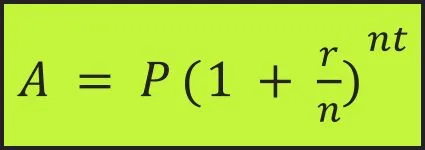| Total savings | |
| Total monthly contributions | |
| Interest earned |
Savings calculator
Find out what your Canadian dollars could be worth in the future with our monthly compound interest calculator.


Compound interest puts your Canadian dollars to work while you sleep. Over time, your initial deposit can snowball into much more than you realize. Use our savings calculator to find out what setting aside money today could do for your life years from now, and learn how the compound interest formula works.
| Total savings | |
| Total monthly contributions | |
| Interest earned |
Here’s the formula for compound interest:
For most savings accounts, your interest is compounded monthly, or 12 times per year. For long-term savings products like Guaranteed Investment Certificates (GICs), the formula or compounding period might differ.
The compound interest formula is much simpler if you know your bank savings account balance at the end of the business day. Here’s how most banks calculate compound interest on savings account balances:
With most bank savings accounts, interest begins accumulating when you make a deposit and is calculated on your daily closing balance. Typically, your account will be credited at the end of the month (12 times per year). Earnings can be used or spent the same day.
If you close your account, any accumulated interest is deposited the day it’s closed.
Say you deposit $5,000 into a savings account that pays 1.5% interest. For simplicity, we’ll assume there are no bank fees, and you don’t make any subsequent deposits or withdrawals.
If interest compounds daily, or 365 times per year, here’s what you’d earn over five years:
| Principal (P) | Rate (r) | Compound (n) | Time (t) | Annual interest earned |
|---|---|---|---|---|
| $5,000 | 1.5% | 365 | 1 | $75.56 |
| $5,000 | 1.5% | 365 | 2 | $152.27 |
| $5,000 | 1.5% | 365 | 3 | $230.13 |
| $5,000 | 1.5% | 365 | 4 | $309.18 |
| $5,000 | 1.5% | 365 | 5 | $389.41 |
If interest compounds monthly, or 12 times per year, here’s what you’d earn over five years:
| Principal (P) | Rate (r) | Compound (n) | Time (t) | Annual interest earned |
|---|---|---|---|---|
| $5,000 | 1.5% | 12 | 1 | $75.52 |
| $5,000 | 1.5% | 12 | 2 | $152.18 |
| $5,000 | 1.5% | 12 | 3 | $229.99 |
| $5,000 | 1.5% | 12 | 4 | $308.98 |
| $5,000 | 1.5% | 12 | 5 | $389.17 |
If interest compounds quarterly, or four times per year, here’s what you’d earn over five years:
| Principal (P) | Rate (r) | Compound (n) | Time (t) | Annual interest earned |
|---|---|---|---|---|
| $5,000 | 1.5% | 4 | 1 | $75.42 |
| $5,000 | 1.5% | 4 | 2 | $151.98 |
| $5,000 | 1.5% | 4 | 3 | $229.70 |
| $5,000 | 1.5% | 4 | 4 | $308.59 |
| $5,000 | 1.5% | 4 | 5 | $388.66 |
If interest compounds annually, or once per year, here’s what you’d earn over five years:
| Principal (P) | Rate (r) | Compound (n) | Time (t) | Annual interest earned |
|---|---|---|---|---|
| $5,000 | 1.5% | 1 | 1 | $75.00 |
| $5,000 | 1.5% | 1 | 2 | $151.13 |
| $5,000 | 1.5% | 1 | 3 | $228.39 |
| $5,000 | 1.5% | 1 | 4 | $306.82 |
| $5,000 | 1.5% | 1 | 5 | $386.42 |
Often used to bank savings calculations, compound interest is paid on your initial deposit plus any interest earned. The amount you invest in a savings account earns interest, which is rolled into the total investment. The total investment continues earning interest—only this time, on a bigger balance than before.
Often used for loans, simple interest is only calculated on the original loan amount (the principle). Interest is not part of the calculation.
From a 4% to a 5% interest savings account, here’s how to find the best savings rates in Canada.
Compare current savings account interest rates so you can grow your savings.
Earn a high interest rate on your savings with no minimum deposit requirements and no monthly fees with the Neo Money Account.
Your guide to how TFSAs and RRSPs work, and how to choose the right account for your savings goals.
Discover how to budget for a new home, save effectively and plan for ongoing expenses.
Explore how to create an emergency fund in Canada and where to grow your savings.
Maximize your savings with a TFSA, enjoying tax-free growth, flexible withdrawals and diverse investment options.
Start saving for your retirement at any age by learning about registered retirement savings plans.
Compare the best high-interest savings accounts in Canada to build a bigger bank balance.
Find out about competitive interest rates, minimal fees and other perks you can enjoy when you bank at a nonprofit institution.